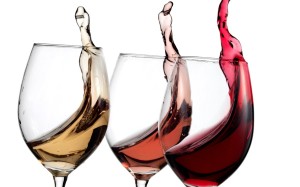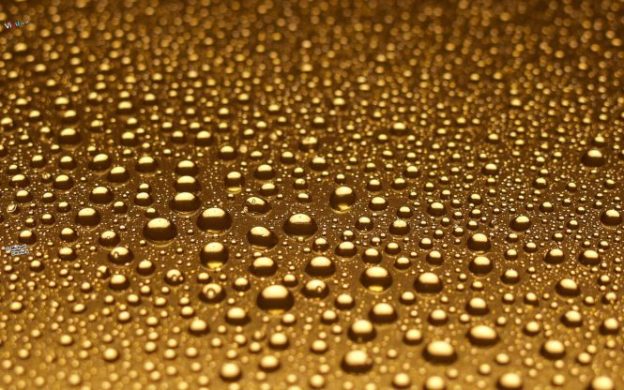If Freyja wept tears of gold, we would expect them to be the colour of the drops above, right? However, in the Prose Edda, Snorri describes them as “red gold”, rauðr gull. (Gylf. 46) Was this just poetic license, or was gold different in the Middle Ages?
Old Norse poetry often referred to red gold:
The modifying phrases used in Old Norse are raut gull ‘red gold’ and bleikt gull ‘bright gold’… Old Norse also has raud mani ‘red moon’ and et rauða ‘egg yolk’. Among the twenty-eight times that read- is used in Old English poetry, the phrase read gold appears four times. Read- modifies gold about twenty-one times in the Old English corpus, and it modifies blod about twelve times. (Anderson: 133)
(Which at least shows that they knew what “red” looked like.) Anderson goes on to give other instances in Medieval English poetry, as well as in other languages, which suggest that the idea of red gold was pretty common in Europe, at least until the late Middle Ages, when yellow became the common adjective for gold.
Gold was also described as blóðrauðr, blood-red, or glóðrauðr, ember-red, and there was even an adjective form, gullroðínn, gold-reddened. (Crawford: 246) In the Eddic poem Voluspa, too, the rooster who sits on top of the world-tree is called Gullinkambi, Gold-Comb.
Was medieval gold red?
We expect red gold to look like the middle ring,

which is gold with a copper alloy. “Rose gold”, as jewllers now call it, is popular, as a quick search on Google will show. Jewellers consider it a novelty item, however, which brings us back to the question, was medieval gold red, or did they just describe it that way?
One theory is that medieval people prized red gold above the ordinary kind. (Alternatively, some have suggested that the red sort was commoner than the yellow in those days.)
However, a quick glance at images of Classical or Medieval gold items shows they are the golden colour we moderns are used to. If you want to see artifacts of red gold, you need to look in the Chinese section of the museum, apparently. (Anderson: 134)
Colour names and reality
Other theories about “red” gold have focused on the everyday fact that many things described as being a certain colour aren’t, really. Wine is a good example, also human skin colour. (How many of us as small children have objected that white, yellow and black people are nothing of the kind?) Those of us who garden know just how elastic the word “blue” can be, although in this case commerce plays a role.
 It is easy to forget that adjectives are conventions, and they work as long as everyone understands the convention. (Adjectives are signs, which correspond to real-life referents, but how they refer to those real-life objects is mediated by human culture, as the intellectuals would say.)
It is easy to forget that adjectives are conventions, and they work as long as everyone understands the convention. (Adjectives are signs, which correspond to real-life referents, but how they refer to those real-life objects is mediated by human culture, as the intellectuals would say.)
Linguists who study colour names say that “red” is the first real colour-word that appears in languages. (Black and white are, technically, not colours.) There are many theories as to why this might be, but it seems to be universal. The original theory of colour differentiation broke it down into stages.
- Stage One, two colours: light/warm (white/red/yellow) vs. dark/cool (black/green/blue)
- Stage Two, three colours: white, red/yellow, black/green/blue
(It goes on to five stages, with twelve basic colours.)
Red usually refers to any bright colour, as opposed to the black-gray-white that defines dark things and light things. Next, we usually get a division between the warm and cool ends of the spectrum.
Presumably then the Norse and English were both describing warm-hued objects as “red” whether they were actually reddish or dark yellow. (They did have a word for bright yellow or pinkish things as well: bleikr, which could describe a the colour of a face, or a bird’s feet.)
Crawford notes that in the story Rauðúlfs thattr red gold is contrasted with “less desirable” yellow gold, bleikt gull, and suggests that the “red” part may indicate purity and good colour, rather than any redness. (246) That bleikr could indicate paler versions of rauðr seems to back this up.
The word for white, hvítr, often modifies silver in the same way, sometimes as “snow-white”, mjallhvítr or snæhvítr. The word grár, gray, indicates silver of lesser quality, although it’s very rare.
The importance of red
We’re still left with the question of why better gold would be “red” and silver “white”. Why do we favour red?
As I mentioned above, linguists say that after people distinguish black and white, giving them names, red comes next. So it’s not surprising that two valuable metals would be compared to two of the most basic colour terms we have, especially if we’re talking about their purity. That later-developing colour names are used for impure metal bears this out.
Another theory goes back to the use of ochre, which comes in yellowish and reddish hues, by our distant ancestors. (It has been found all over the world, from Africa to the U.S.) They used it for art, body decoration, and funeral rites, among other things.
Some trace the use of the term “Red Indian” to the body paint the Newfoundland Beothuks used. (The reddish hue in ochre, by the way, comes from the iron ore, or hematite, content, not copper.) Humans have valued red for a long time.
Red was therefore important both symbolically and aesthetically. The associations of red are still more compelling than those for yellow: danger, blood, and love instead of sunshine, cowardice, and sickness.
And of course, we would expect a goddess to weep tears of pure gold, rather than an inferior alloy. Especially Freyja, the goddess whose daughters are both named Treasure, whose family is known for their wealth and generosity.
References:
Edda, Snorri Sturluson/Anthony Faulkes, Everyman Press, Penguin, 1992. (reprint)
Crawford, Jackson 2016: Bleikr Gulr and the Categorizaton of Colour in Old Norse in the Journal of English and German Philology: 239-52.
Anderson, Earl R. 2003: Folk-Taxonomies in Early English, Fairleigh Dickinson University Press.
Links:
Nautilus article on Colour Categories
Alphabetic Index of the Cleasby/Vigfusson Icelandic Dictionary
Article on the Origin of Traffic Light Colours
Neanderthals and Red Ochre



Intriguing! I can see where “red” would be the more appealing adjective over “yellow,” even if we don’t really see too much red in pure gold. It appears red is synonymous with a level of brightness or richness of color, if I read your article correctly. I wonder if it was used in other instances? “Red” sun meaning a bright, sunny day? “Red” stars that stood out from others — and today we might think they were talking about Mars?
LikeLiked by 1 person
I hadn’t thought about that – but the red sun is worth looking into. Red for the sun and white for the moon are traditional, and could tie into the same idea of intenser colours being more meaningful.
LikeLiked by 1 person
Interesting discussions here about the perceived ideas of colours. I wonder because in traditional Australian history going back millions of years we have rich gold resources called red, and rose gold. In opals more than the usual colours known to early man emerge. What do you think about ochre …..Its been around for ?? and is in all dreamtime legends. Found the article interesting and informative. Thank you.
LikeLiked by 1 person
Ocher seems to go back to our origins in Africa (http://archaeology.about.com/od/oterms/qt/Ochre.htm). I didn’t know about Australia and red gold, I’ll have to look that up and maybe add a link.
LikeLike
Interesting post. Here in Sweden goldsmiths still refer to pure gold as “rödguld” (red gold). This inspires me to DI some research…
LikeLike
Good to know – thanks for passing that along!
LikeLike
Pingback: Weeping Tears of Amber | We Are Star Stuff
Pingback: Mardoll’s Tears and the Shining Sea | We Are Star Stuff
bread
LikeLike